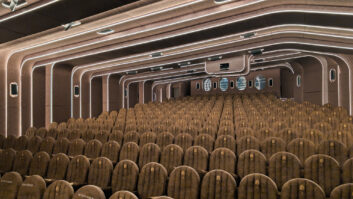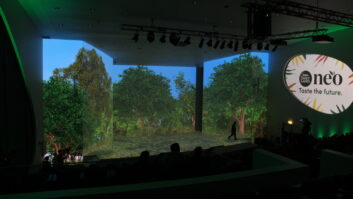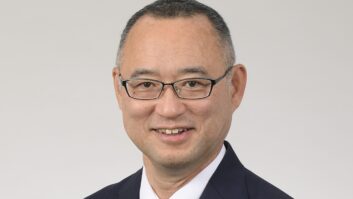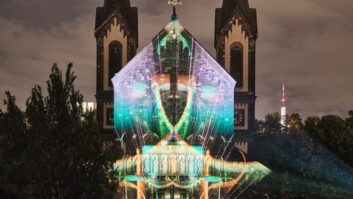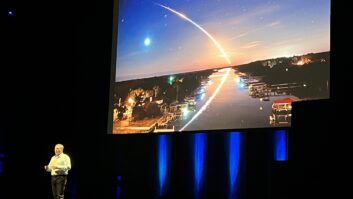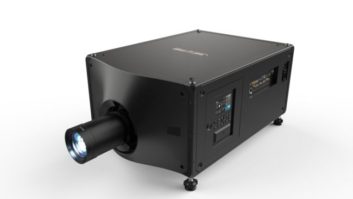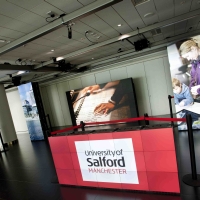
The University of Salford’s unique digital learning, teaching and research space is located at MediaCityUK — the major development in Salford Quays which is also home to the BBC and independent creative, digital and media organisations.
The public area on the ground floor is dominated by a digital interactive showcase that includes a formal presentation space and ten interactive touch tables — designed to engage with visitors. The central feature is a high resolution display wall made up from 120 Christie MicroTiles, able to display images of 9,600 × 3,840 resolution. Electrosonic was the systems integrator for the project.
The building is home to 1,500 students and staff, offering both undergraduate and postgraduate courses in all aspects of radio, TV, computer games, and digital media production, as well as providing research facilities.
The entrance area of the new building itself is known as ‘The Egg’, and is described as “a publicly accessible digital interactive showcase for visitors and students”. It has been designed as a flexible space where resources can be deployed in different ways — for instance it can be used for research — or to display research by other facilities, with cameras and PCs installed for motion tracking.
The original technical design for the space was prepared by The Centre for Virtual Environments at the University of Salford, and Electrosonic was awarded the contract to engineer and install the complete system.
The MicroTiles wall has initially been installed as a 15 x 8 array; however, in future, the Tiles may be redeployed to achieve project-specific layouts (such as 12 x 10 or 20 x 6).
The Christie solution was adopted by the University following Electrosonic’s recommendation. It was a pre-condition that the wall display should be free-standing on the raised floor and not require any structural fixings to the building. This necessitated the design and construction of a suitable support frame, and Electrosonic enlisted the services of Long & Co of Dartford to handle the structural engineering. Additional framework was supplied for use when the wall is broken down into smaller blocks.
The display is fed from a number of DVI computer sources. Two 7thSense Delta Media Servers, each fitted with 4-head graphics cards, output an overall resolution of 8,000 x 3,200 (in native 8K video format). There is an additional NVIDIA Quadro 7000 connected to a workstation with an output of 4,000 x 1,600, while all other PC/Mac sources are 1,920 x 1,080. In addition, there are SDI tie lines to the TV studios in the building while all DVI sources and the DVI inputs from two Christie Spyder X20 1608 video processors are connected to a Lightware Matrix.
The Spyders operate in master/slave configuration — one managing the top half of the screen while the other handles the bottom. All outputs are used with the Lightware Fibre Optic extenders to the 16 ECUs.
The video wall itself and the whole space around it are intended to be used for future student and research projects. Equipment for this purpose includes three projectors aimed at the floor and six machine vision cameras. This combination is intended to allow the development of projects based on gesture and image recognition.
Within the main space there are also ten interactive touch tables for use by students and the general public. Here, Electrosonic was required to deliver working systems complete with initial content. The interactive software was produced under sub-contract by Stardotstar, a Manchester-based content producer.
The initial design envisaged 32-inch panels with capacitive sensors, but in developing the design, the decision was taken to move to 40-inch panels with multi-touch infra-red sensors from PQ Labs. The touch tables are driven by Mac Mini computers that are centrally rack-mounted in the control room. Extron USB over CAT5 extenders are used.
Behind the videowall is the enclosed Presentation Area which can be used for formal presentations, both informal and formal meetings and for research projects. The room layout can be changed, but there is a large front projection screen that is permanently installed, served by a Christie DHD800 projector. This can be sourced from any compatible source device in the control room, or from a presenter’s computer.
Electrosonic also designed and provided full and flexible audio control and sound reinforcement in both the Egg and Presentation spaces. The initial configuration is as a 5:1 and 2:1 system; however, the equipment can be re-located or augmented for different projects.
A separate control room houses all source, control and routing equipment, with six racks accommodating the equipment. Here can be found the Christie Spyder X20 1608 processors, three Extron DVS304DVI scalers for analogue sources, eight Lightware DA2DVI DL dual link DVI distribution amplifiers, and four Extron MDA4V HD-SDI distribution amplifiers. 29 Lightware TX/RX110 DVI fibre extenders are used for signal distribution and a Medialon Showmaster ST is installed for housekeeping and every day user interface.
The overall system is unusual in that it is at the same time an experimental facility and a showcase, and the University will be exploring how best to manage it in a way that achieves both objectives.
